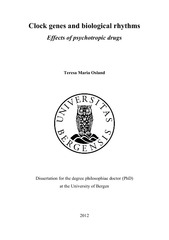| dc.contributor.author | Osland, Teresa Maria | en_US |
| dc.date.accessioned | 2013-01-16T13:58:05Z | |
| dc.date.available | 2013-01-16T13:58:05Z | |
| dc.date.issued | 2012-11-16 | eng |
| dc.identifier.isbn | 978-82-308-2134-3 | en_US |
| dc.identifier.uri | https://hdl.handle.net/1956/6271 | |
| dc.description.abstract | The sleep-wake cycle, lipid metabolism and hormone levels are examples of circadian rhythms, which are endogenously generated cycles that reach both maximum and minimum values once in the course of 24 hours. In mammals, circadian rhythms are regulated by a set of clock genes that are functionally linked, and polymorphisms in these genes may be associated with variations in circadian rhythms. Disruption of the circadian clock has been associated with poor physical health, including metabolic disturbances such as obesity and dyslipidemia, as well as mental illness, including bipolar disorder, a severe chronic affective disorder. The mood stabilizer lithium is widely used in the pharmacological treatment of bipolar disorder, and has been shown to affect circadian rhythms, although its molecular mechanisms of action remain largely unknown. In this study, we investigated cultured mice fibroblasts (NIH-3T3 cells) for effects of lithium on the expression of genes that regulate the circadian clock. Robust circadian oscillations of rhythmic clock genes were observed in control and lithium-treated samples in this model of the circadian clock. A main effect of lithium was to differentially alter the amplitude of expression of several clock genes, including an increase in the peak amplitude of Per2 and Cry1, and a reduction of the maximal amplitude of Per3, Bmal1 and Rev-Erb- transcription, indicating a possible role for alteration of oscillation amplitudes of clock genes in the mechanisms of lithium action on biological rhythms. Additional mood stabilizers, antipsychotics and antidepressants are also used in the treatment of bipolar disorder; hence we investigated whether they too affect the transcription of key circadian clock genes. Interestingly, clock gene expression was differentially up- or down-regulated, such as a reduction of Per2 transcription by clozapine and imipramine, and an increase in the expression of Rev-Erb- by clozapine. The observed drug-induced effects could reflect shared regulatory mechanisms that contribute to their psychotropic action. Since numerous antipsychotics and antidepressants are known to induce lipogenic gene expression, and given the suggested link between the circadian clock and lipid metabolism, we also examined their effects on lipid metabolism-related genes. The antipsychotics and antidepressants increased the transcription levels of lipid metabolism genes (which did not oscillate), whereas the mood stabilizers had no such effect, indicating that no evident regulatory link between the circadian clock and lipid metabolism is present in this model system, although it cannot be excluded. Genetic factors are likely to influence diurnal preference (chronotype), and in search of associations between clock gene variants and chronotype, several studies have investigated the role of the clock gene PER3, and found an association between a variable number tandem repeat (VNTR) in PER3 and diurnal preference. However, conflicting findings have been reported, and our replication study on 432 healthy Norwegian students did not confirm the association, indicating that variation in the PER3 VNTR does not appear to be associated with self-report measures of chronotype in our study sample, and suggesting that further studies are needed to clarify the proposed role of PER3. | en_US |
| dc.language.iso | eng | eng |
| dc.publisher | The University of Bergen | eng |
| dc.relation.haspart | Paper I: Osland, T. M., Ferno, J., Havik, B., Heuch, I., Ruoff, P., Laerum, O. D. and Steen, V. M. (2011) Lithium differentially affects clock gene expression in serum-shocked NIH-3T3 cells. Journal of Psychopharmacology 25(7): 924-933, July 2011. Full text not available in BORA due to publisher restrictions. The article is available at: <a href="http://dx.doi.org/10.1177/0269881110379508" target="blank"> http://dx.doi.org/10.1177/0269881110379508</a> | en_US |
| dc.relation.haspart | Paper II: Osland, T. M., Skrede, S., Ferno, J. and Steen, V. M. Transcriptional effects of psychotropic drugs on circadian clock genes and lipid biosynthesis genes in cultured NIH-3T3 cells. Full text not available in BORA. | en_US |
| dc.relation.haspart | Paper III: Osland, T. M., Bjorvatn, B., Steen, V. M. and Pallesen, S. (2011) Association study of a variable-number tandem repeat polymorphism in the clock gene PERIOD3 and Chronotype in Norwegian university students. Chronobiology International 28(9): 764-770, November 2011. Full text not available in BORA due to publisher restrictions. The article is available at: <a href="http://dx.doi.org/10.3109/07420528.2011.607375" target="blank"> http://dx.doi.org/10.3109/07420528.2011.607375</a> | en_US |
| dc.title | Clock genes and biological rhythms. Effects of psychotropic drugs | en_US |
| dc.type | Doctoral thesis | |
| dc.rights.holder | Copyright the author. All rights reserved | |
